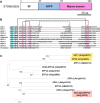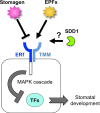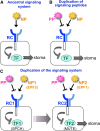Positive and negative peptide signals control stomatal density
- PMID: 21509541
- PMCID: PMC11114932
- DOI: 10.1007/s00018-011-0685-7
Positive and negative peptide signals control stomatal density
Abstract
The stoma is a micro valve found on aerial plant organs that promotes gas exchange between the atmosphere and the plant body. Each stoma is formed by a strict cell lineage during the early stages of leaf development. Molecular genetics research using the model plant Arabidopsis has revealed the genes involved in stomatal differentiation. Cysteine-rich secretory peptides of the EPIDERMAL PATTERNING FACTOR-LIKE (EPFL) family play crucial roles as extracellular signaling factors. Stomatal development is orchestrated by the positive factor STOMAGEN/EPFL9 and the negative factors EPF1, EPF2, and CHALLAH/EPFL6 in combination with multiple receptors. EPF1 and EPF2 are produced in the stomatal lineage cells of the epidermis, whereas STOMAGEN and CHALLAH are derived from the inner tissues. These findings highlight the complex cell-to-cell and intertissue communications that regulate stomatal development. To optimize gas exchange, particularly the balance between the uptake of carbon dioxide (CO(2)) and loss of water, plants control stomatal activity in response to environmental conditions. The CO(2) level and light intensity influence stomatal density. Plants sense environmental cues in mature leaves and adjust the stomatal density of newly forming leaves, indicating the involvement of long-distance systemic signaling. This review summarizes recent research progress in the peptide signaling of stomatal development and discusses the evolutionary model of the signaling machinery.
Figures





Similar articles
-
Take a deep breath: peptide signalling in stomatal patterning and differentiation.J Exp Bot. 2013 Dec;64(17):5243-51. doi: 10.1093/jxb/ert246. Epub 2013 Aug 30. J Exp Bot. 2013. PMID: 23997204 Review.
-
The signaling peptide EPF2 controls asymmetric cell divisions during stomatal development.Curr Biol. 2009 May 26;19(10):864-9. doi: 10.1016/j.cub.2009.03.069. Epub 2009 Apr 23. Curr Biol. 2009. PMID: 19398336
-
The signalling peptide EPFL9 is a positive regulator of stomatal development.New Phytol. 2010 May;186(3):609-14. doi: 10.1111/j.1469-8137.2010.03200.x. Epub 2010 Feb 10. New Phytol. 2010. PMID: 20149115
-
Stomagen positively regulates stomatal density in Arabidopsis.Nature. 2010 Jan 14;463(7278):241-4. doi: 10.1038/nature08682. Epub 2009 Dec 9. Nature. 2010. PMID: 20010603
-
Mix-and-match: ligand-receptor pairs in stomatal development and beyond.Trends Plant Sci. 2012 Dec;17(12):711-9. doi: 10.1016/j.tplants.2012.06.013. Epub 2012 Jul 21. Trends Plant Sci. 2012. PMID: 22819466 Review.
Cited by
-
Investigation on the Potential Functions of ZmEPF/EPFL Family Members in Response to Abiotic Stress in Maize.Int J Mol Sci. 2024 Jun 29;25(13):7196. doi: 10.3390/ijms25137196. Int J Mol Sci. 2024. PMID: 39000300 Free PMC article.
-
Small post-translationally modified Peptide signals in Arabidopsis.Arabidopsis Book. 2011;9:e0150. doi: 10.1199/tab.0150. Epub 2011 Sep 26. Arabidopsis Book. 2011. PMID: 22303274 Free PMC article.
-
EPFL Signals in the Boundary Region of the SAM Restrict Its Size and Promote Leaf Initiation.Plant Physiol. 2019 Jan;179(1):265-279. doi: 10.1104/pp.18.00714. Epub 2018 Nov 8. Plant Physiol. 2019. PMID: 30409857 Free PMC article.
-
Small signaling peptides in Arabidopsis development: how cells communicate over a short distance.Plant Cell. 2012 Aug;24(8):3198-217. doi: 10.1105/tpc.112.099010. Epub 2012 Aug 28. Plant Cell. 2012. PMID: 22932676 Free PMC article. Review.
-
StEPF2 and StEPFL9 Play Opposing Roles in Regulating Stomatal Development and Drought Tolerance in Potato (Solanum tuberosum L.).Int J Mol Sci. 2024 Oct 5;25(19):10738. doi: 10.3390/ijms251910738. Int J Mol Sci. 2024. PMID: 39409067 Free PMC article.
References
Publication types
MeSH terms
Substances
LinkOut - more resources
Full Text Sources
Molecular Biology Databases

